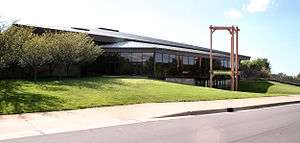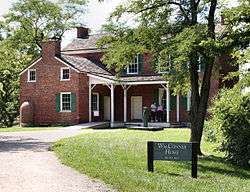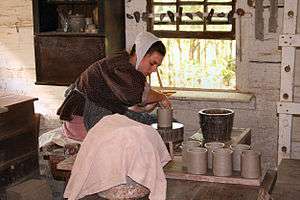Conner Prairie
|
| |
| Established | 1930s |
|---|---|
| Location |
13400 Allisonville Road Fishers, Indiana |
| Coordinates | 39°59′04″N 86°01′44″W / 39.984530°N 86.028864°WCoordinates: 39°59′04″N 86°01′44″W / 39.984530°N 86.028864°W |
| Type | Living History Museum |
| Website |
www |
Conner Prairie is an interactive history park, or living history museum, in Fishers, Indiana, United States, that preserves the William Conner home, which is listed on the National Register of Historic Places, and recreates part of life in Indiana in the 19th century on the White River.
History and development

Conner Prairie was founded by pharmaceutical executive Eli Lilly in the 1930s. In 1974, Lilly transferred the William Conner house, which he had restored, and related outbuildings to a public charitable trust of which Earlham College, a Quaker liberal arts college in Richmond, Indiana, was named as trustee. Lilly also transferred about 1,400 acres (570 ha) of surrounding farmland to the college with the expectation that Earlham would sell that land and use the proceeds to provide an endowment for the museum. Instead, Earlham elected to retain the farmland and expand the museum, constructing an 1836 village, Prairietown, using funds that Lilly provided for this purpose. The museum grew in scope and popularity. In 1992 Earlham created a wholly owned subsidiary to run the museum and appointed a local volunteer board of directors, while retaining financial control over the museum's operations. Beginning in 1999, tension began to develop between the board of directors and Earlham regarding the museum's governance and the college's financial policies. The dispute culminated in Earlham's dismissal of the board of directors and president of the museum in June 2003. The Indiana Attorney General intervened and, after a lengthy and contentious dispute, a settlement was reached under which Earlham resigned as trustee of the public charitable trust, the Lilly endowment was allocated between Conner Prairie and the college and the museum became completely independent. Conner Prairie now has its own board of directors and maintains its own finances and endowment fund. In 2009, Conner Prairie became an affiliate in the Smithsonian Affiliations program.[1]
On December 17, 2010, Conner Prairie was awarded the National Medal for Museum and Library Service and a $10,000 prize in a ceremony at the White House.[2]
The living museum opened its newest exhibit in June 2011. The 1863 Civil War Journey: Raid on Indiana documents Morgan's Raid with live action, video, and interactive activities.[3]
Layout and concept

The museum grounds are divided into several sections, where different eras in history are recreated to create a kind of living timeline. Staff in historical clothing demonstrate the way early inhabitants in the area lived. They explain their lifestyles in character while performing chores such as cooking, chopping wood, making pottery, and tending to animals. Patrons are often invited to join in the activities.
The museum's main building, called the Welcome Center, contains the entrance lobby, ticket sales counter, Create.Connect (History and Science exhibits), Discovery Station/Craft Corner indoor play area, banquet hall, and gift shop. The gift shop sells pottery made by the museum's costumed staff as well as more conventional souvenirs.
Attractions
Conner Prairie features several permanent attractions and numerous semi-regular events, including special monthly programming such as "Taste the Past", a "Headless Horseman ride" in the autumn, candlelight tours, and a country fair. It also hosts American Civil War reenactments, "Hearthside Suppers", and Christmas holiday events and dinners.
William Conner House
|
William Conner House | |
 Conner's House in Fishers, Indiana | |
  | |
| Location |
13400 Allisonville Road Fishers, Indiana |
|---|---|
| Coordinates | 39°59′3.5″N 86°1′52.8″W / 39.984306°N 86.031333°W |
| Built | 1823 |
| Architectural style | Federal |
| NRHP reference # | 80000038[4] |
| Added to NRHP | February 8, 1980 |
Built in 1823, the William Conner House is a two-story, Federal-style brick residence on the terrace edge of the west fork of the White River. The house is believed to be one of the first brick buildings erected in central Indiana. Seven of William and Elizabeth Conner's ten children were born in the home. In addition, the house was used as the meeting place for the commissioners, other county officials, and the circuit court of Hamilton County, Indiana, and served a post office in the county's early days.[5] Conner lived in the house until 1837. William and Elizabeth Conner's children and their families or their tenants continued to reside in the house until ownership passed outside the family 1871. In the 1860s, Conner's Delaware children that he had with Mekinges Conner unsuccessfully attempted to gain title to the family's Indiana land.[6][7][8]
Various owners continued to use the house as a residence until 1934, when Eli Lilly Jr. purchased Conner's former farm and the dilapidated house. Lilly, the president and CEO of Eli Lilly and Company who also served as president of the Indiana Historical Society at the time, intended to restore the house and turned it into a museum.[7][9] Local architect Robert Frost Daggett and contractor Charles Latham supervised the home's stabilization and restoration work, as well as the addition of a new, six-columned porch overlooking the White River. (The porch was removed in a later renovation.) Lilly donated the house and farm to Earlham College in 1963 and it subsequently became part of Conner Prairie.[6] In 1980, the William Conner House was listed in the National Register of Historic Places.[4]
The Conner House has undergone additional restoration and is preserved as a representation of an 1820s-era home. Its interpretation as a house museum continues to evolve.[10] The home is open to visitors of Conner Prairie, where they can hear about the daily lives of pioneer-era Hoosiers, including how they cooked, spun and dyed thread and yarn, and cared for their animals and crops, among other activities.
1863 Civil War Journey
The 1863 Civil War Journey: Raid on Indiana documents Morgan's Raid, the longest raid of the Civil War behind enemy lines and the most important event of the Civil War on Indiana soil. Using live action, video, and other interactive activities, the Civil War Journey documents the raid as seen through the eyes of historical figures, notably miss Attia Porter, Confederate brigadier general John Hunt Morgan, and Albert Cheetham.[3] In this exhibit, visitors will be able to walk through a reconstruction of the town of Dupont and be a part of the Civil War conflict. Children can also board a replica steam boat, then play in the water area.[11]
The Civil War Journey is set in the town of Dupont, a southern Indiana town that was invaded by Confederate raiders during the 1863 raid. Visitors can stop by the Mayfield and Nichols Dry Goods Store and the Porter Family home, as well as a telegraph station, soldiers' camp, and field hospital. Although much of the Civil War Journey is presented through the use of technology, historic interpreters also play a large part in the presentation of the site. Guests can talk to soldiers of the 103rd Indiana Regiment and the citizens of Dupont, who are willing to share their views on the war and Morgan's Raid. Occasionally, reenactors portraying various Union and Confederate units are also present at the site, which gives a more in-depth portrait of the raid.
1836 Prairietown

Prairietown is a recreated pioneer community set in 1836. Unlike the Civil War Journey, Prairietown is not an actual Indiana settlement, but rather a fictitious recreation of what such settlement may have been like in the early days of Indiana's statehood. Along with several residences, Prairietown has its own blacksmith shop, pottery shop, inn, doctor's office, and schoolhouse. Visitors arriving early in the day might help with morning chores. Guests are also invited to take a role in Prairietown society using one of the character cards found at the entrance to the site. Rather than focussing on a single event, Prairietown shows what day-to-day life was like for the citizens of frontier Indiana. Historic Interpreters dressed in period clothing and doing first-person impressions of the people of Prairietown are throughout the site, and can help give a unique picture of what life was like in their time period. True to their era, these interpreters will not discuss of any events or inventions that came about after 1836. However, blue shirted employees scattered throughout the site can help guests approach Prairietown from a modern point of view.
1859 Balloon Voyage
On June 6, 2009, Conner Prairie opened the 1859 Balloon Voyage. Visitors can take 15-minute rides in a tethered balloon to a height of 377 feet (115 m). The balloon is filled with 210,000 cubic feet (5,900 m3) of helium and is 105 feet (32 m) tall, making it the largest tethered gas passenger balloon in the world.[12] The gondola can carry up to about twenty people and the balloon can lift up to 4.5 tons. The ballon was manufactured by the French company Aerophile. There are currently only five of these balloons in the United States.
An educational exhibit accompanies the balloon voyage. The exhibit is a recreation of a Lafayette streetscape and includes several hands-on, interactive elements that teach the historical context and the technology of ballooning. The entire attraction is based on the historic August 17, 1859 trip of Aeronoaut John Wise, where he made the first airmail delivery in the United States 25 miles (40 km) from Lafayette, Indiana to Crawfordsville, Indiana carrying 123 letters and 23 circulars.[13][14]
Sunset and nighttime flights do occur on weekends when the Indianapolis Symphony Orchestra is playing their Symphony on the Prairie summer series. The balloon ride is dependent on weather and must be landed during high winds. This is a permanent addition to Conner Prairie and is open with the rest of the park from April to October.
Lenapehoking
Lenapehoking recreates bark and cattail mat wigwams and a fur trade camp with a log cabin. Visitors can learn how the Lenape (Delaware Indians) lived in Indiana and hunted and trapped animals to trade with white fur traders. Also there are tomahawk throws which demonstrates one of the skills needed for the hunting trips. Throwing the tomahawks would increase hand eye coordination as well as accuracy.
Summer camp
The summer camp is a one-week-long camp in which children get to ride on horses, swim in a lake, and learn archery. The camp is operated on a part of Conner Prairie that is not open to the public. The camp is from 8:30 a.m. to 3:30 p.m., and is open to children from the age of five to 15.[15] They have several different camps, including an adventure camp, maker camp, archeology camp, art camp and science camp for girls.[16]
Other events
Conner Prairie serves as the summer home of the Indianapolis Symphony Orchestra. The Friday/Saturday Symphony on the Prairie concert series, sponsored by Kroger, attracts some 100,000+ concert goers each year, a substantial percentage of Conner Prairie's annual visitor count.
Spirit of the Prairie Awards
The Spirit of the Prairie Awards began in 1998. The event honors individuals who demonstrate "excellence in achievement, courage, innovation and vision," all of which are characteristics shown by those establishing the United States. The awards are Conner Prairie Museum's highest honors.
References
- ↑ Alpha Garrett (2009). "Conner Prairie releases documentary: "History Rising, a Conner Prairie Balloon Adventure"". Indianapolis Star. Archived from the original on 27 March 2012. Retrieved 15 Jul 2011.
- ↑ Reason, Betsy (15 December 2010). "First lady to honor Conner Prairie at White House". Indianapolis Star. Retrieved 18 December 2010.
- 1 2 "Conner Prairie to Launch New $4.3 Million Exhibit". Inside Indiana Business. December 1, 2010. Archived from the original on 8 December 2010. Retrieved 18 December 2010.
- 1 2 National Park Service (2010-07-09). "National Register Information System". National Register of Historic Places. National Park Service.
- ↑ Larson, John Lauritz, and David G. Vanderstel (December 1984). "Agent of Empire: William Conner on the Indiana Frontier, 1800–1835". Indiana Magazine of History. Bloomington: Indiana University. 80: 318. Retrieved January 19, 2018. See also: David G. Vanderstel, “William Conner” in David J. Bodenhamer and Robert G. Barrows, eds. (1994). The Encyclopedia of Indianapolis. Indiana University Press. p. 471. ISBN 978-0-253-31222-8. Retrieved 2008-12-29.
- 1 2 Cox, Stephen (Winter 1993). "New Life: Eli Lilly and the First Restoration". Traces of Indiana and Midwestern History. Indianapolis: Indiana Historical Society. 5 (1): 24–27. Retrieved January 23, 2018.
- 1 2 Huser, William A. (September 15, 2003). "The William Conner Housesite". Glenn Black Laboratory of Archaeology and The Trustees of Indiana University. Archived from the original on March 11, 2009. Retrieved 2009-06-05.
- ↑ "Indiana State Historic Architectural and Archaeological Research Database (SHAARD)" (Searchable database). Department of Natural Resources, Division of Historic Preservation and Archaeology. Retrieved 2016-04-01. Note: This includes Myron Vourax (November 1979). "National Register of Historic Places Inventory Nomination Form: William Conner House" (PDF). Retrieved 2016-04-01. and Accompanying photographs.
- ↑ Madison, James H. (2006). Eli Lilly: A Life, 1885–1977 (2nd ed.). Indianapolis: Indiana Historical Society Press. pp. 83, 154, 172–82. ISBN 0-87195-197-5.
- ↑ Cox, Stephen (Winter 1993). "Back to the 1820s: The Re-restoration". Traces of Indiana and Midwestern History. Indianapolis: Indiana Historical Society. 5 (1): 28–33. Retrieved January 23, 2018.
- ↑ Conner Prairie. "1863 Civil War Journey". 1863 Civil War Journey: Raid on Indiana. Conner Prairie. Archived from the original on 2011-04-14. Retrieved 2011-04-18.
- ↑ "Helium balloon voyage over Conner Prairie". WTHR Eyewitness News. June 2, 2009. Archived from the original on June 29, 2011. Retrieved 2009-06-05.
- ↑ "Conner Prairie's Newest Exhibit Takes Flight". Inside Indiana Business. 2009-05-05. Archived from the original on 2012-02-29. Retrieved 2009-06-05.
- ↑ Ritchie, Carrie (June 2, 2009). "Conner Prairie balloon goes up Saturday". The Indianapolis Star. Retrieved 2009-06-05.
- ↑ "Archived copy". Archived from the original on 2015-08-11. Retrieved 2015-07-05.
- ↑ "Archived copy". Archived from the original on 2015-06-30. Retrieved 2015-07-05.
External links
| Wikimedia Commons has media related to Conner Prairie. |
- Conner Prairie website
- New York Times article
- William Conner Farm Architectural Drawings Collection, a digital collection of site plans and architectural drawings created by architect Robert Frost Daggett of the William Conner Farm.
- Conner Prairie Historic Clothing Collection - IUPUI University Library
- Conner Prairie Historical Almanac Collection - IUPUI University Library
- Historic American Buildings Survey (HABS) No. IN-46, "William Conner House, Highway 234, Noblesville, Hamilton County, IN", 4 photos

